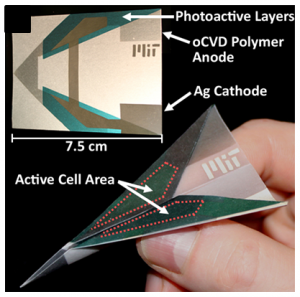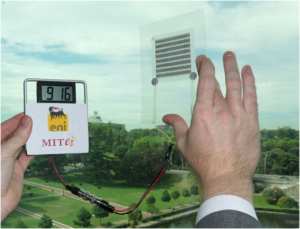Paper-thin and Paper-based Organic Photovoltaics
- Category: Electronic Devices, Energy
- Tags: Karen Gleason, Richard Lunt, Vladimir Bulovic
There is emerging interest in the ability to produce low-cost and lightweight solar cells and other electronics on flexible, stretchable, and foldable substrates. Rigid glass or silicon substrates in the current designs represent a large fraction of the overall module cost [1] and also restrict how and where modules can be deployed. Thus, a shift to the design of modules specifically on low-cost substrates could open untapped locations for solar deployment, including formats that are ubiquitous in our society (e.g., textiles, window curtains, printed paper documents, and wall paper). For example, photovoltaic (PV) devices fabricated directly on common fiber-based paper substrates are also foldable and rollable for storage and portability, easily shaped for three-dimensional applications, and able to be stapled to the roof structures or glued onto walls. To this end, there is significant interest in integrating various electronics to low-cost paper substrates, including transistors, storage devices, and displays [2] [3] . In our work, we examine the use of oxidative chemical vapor deposition (oCVD) [4] [5] in conjunction with organic photovoltaics to fabricate PV cells [6] directly on fiber-based and paper substrates that are both flexible and foldable [7] . For example, in Figure 1 we show a paper PV cell that was folded into a paper airplane (see corresponding video [8] ). Furthermore, we have designed paper-based, monolithically series-integrated arrays that are capable of powering common electronics such as small-format LCD displays under ambient light as shown in Figure 2, with shelf lifetimes greater than several months. These demonstrations allow us to rethink how and where lightweight and potentially low-cost photovoltaics can be deployed.
- Figure 1: A paper airplane with integrated photovoltaic wings, folded from a ~50-cm2 sheet of tracing paper that was first patterned with the oCVD-based device structure.
- Figure 2: Monolithically series-integrated, lamination-encapsulated paper PV array that is capable of powering an LCD clock under ambient lighting conditions.
- K. Zweibel, “The terawatt challenge for thin film photovoltaics,” Thin Film Solar Cells, Hoboken, NJ, John Wiley and Sons Ltd., 2006, pp. 427-459. [↩]
- U. Zschieschang, T. Yamamoto, K. Takimiya, H. Kuwabara, M. Ikeda, T. Sekitani, T. Someya, and H. Klauk, “Organic electronics on banknotes,” Advanced Materials, vol. 23, pp. 654-658, 2011. [↩]
- D. Tobjörk and R. Österbacka, “Paper electronics,” Advanced Materials, vol. 23, pp. 1935-1961, 2011. [↩]
- M. E. Alf, A. Asatekin, M. C. Barr, S. H. Baxamusa, H. Chelawat, G. Ozaydin-Ince, C. D. Petruczok, R. Sreenivasan, W. E. Tenhaeff, N. J. Trujillo, S. Vaddiraju, J. J. Xu, and K. K. Gleason, “Chemical vapor deposition of conformal, functional, and responsive polymer films,” Advanced Materials, vol. 22, pp. 1993-2027, 2010. [↩]
- S. H. Baxamusa, S. G. Im, and K. K. Gleason, “Initiated and oxidative chemical vapor deposition: a scalable method for conformal and functional polymer films on real substrates,” Physical Chemistry Chemical Physics, vol. 11, pp. 5227-5240, 2009. [↩]
- C. W. Tang, “2-Layer Organic Photovoltaic Cell,” Applied Physics Letters, vol. 48, pp. 183-185, 1986. [↩]
- M. C. Barr, J. A. Rowehl, R. R. Lunt, J. J. Xu, A. Wang, C. M. Boyce, S. G. Im, V. Bulovic, and K. K. Gleason, “Paper-thin, organic photovoltaic circuits fabricated directly on ubiquitous, everyday substrates,” Advanced Materials, accepted for publication. [↩]
- Available: http://web.mit.edu/newsoffice/component/mitmultimedia/?type=video&videoid=233 [↩]

